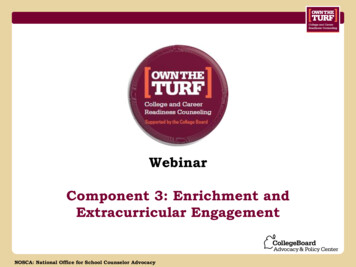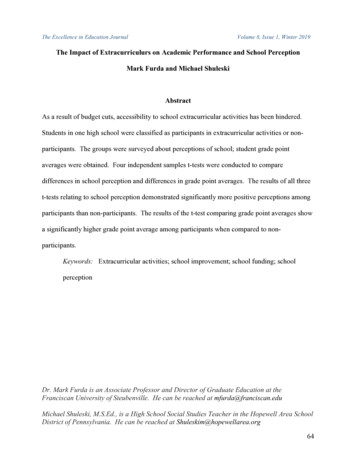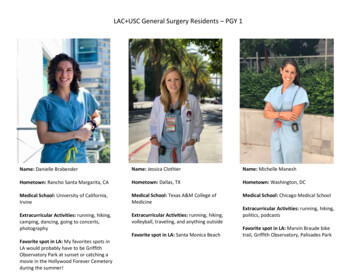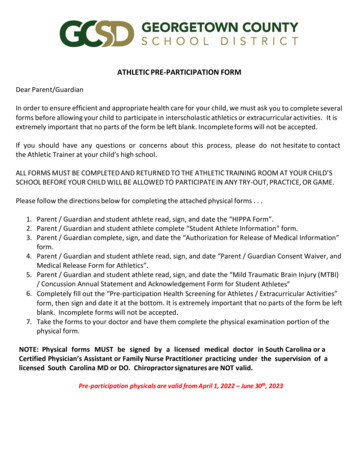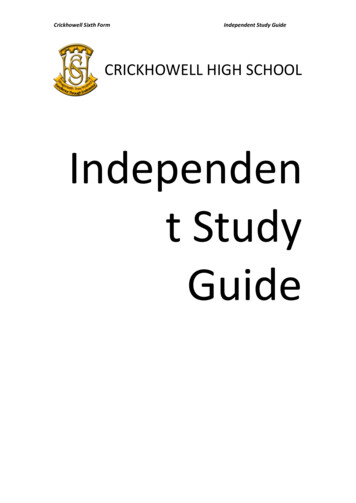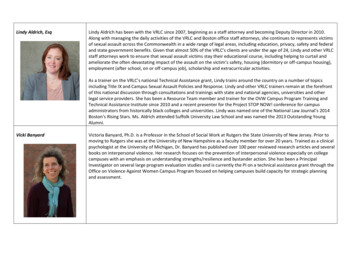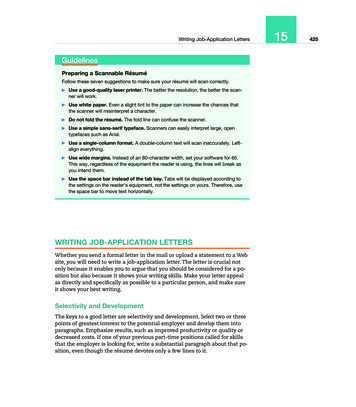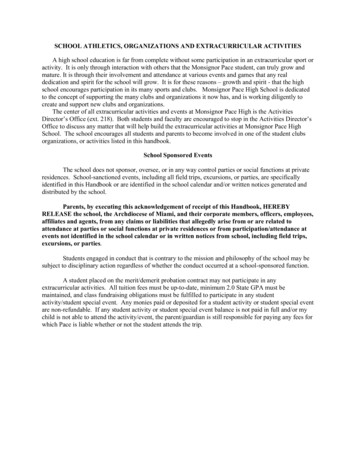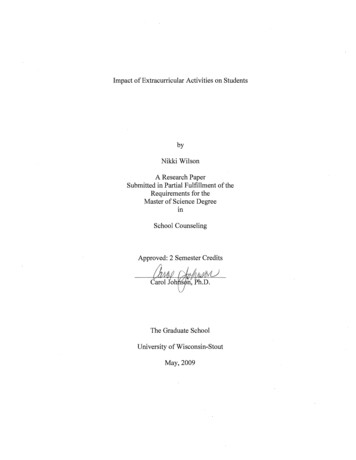
Transcription
Impact of Extracurricular Activities on StudentsbyNikki WilsonA Research PaperSubmitted in Partial Fulfillment of theRequirements for theMaster of Science DegreeIIISchool CounselingApproved: 2 Semester Credits2The Graduate SchoolUniversity of Wisconsin-StoutMay, 2009
iiThe Graduate SchoolUniversity of Wisconsin-StoutMenomonie, WIAuthor:Wilson, Nikki L.Title:Impact of Extracurricular Activities on StudentsGraduate Degree/ Major: MS School CounselingResearch Adviser:Carol Johnson, Ph.D.MonthfVear:May, 2009Number of Pages:39Style Manual Used: American Psychological Association, 5th editionABSTRACTStudents who participate in extracurricular activities generally benefit from themany opportunities afforded them. Benefits of participating in extracurricular activitiesincluded having better grades, having higher standardized test scores and highereducational attainment, attending school more regularly, and having higher a higher selfconcept. Participants in out-of-school activities often learned skills such as teamworkand leadership while decreasing the likelihood of alcohol use and illicit drug use andrelated problem behaviors. Those who participate in out-of-school activities often havehigher grade point averages, a decrease in absenteeism, and an increased connectednessto the school.
iiiStudents who are over-scheduled in too many activities find that thebenefits of participating in out-of-school activities may actually decrease. Overscheduledchildren may be tired, irritable and show little interest in participation. Over schedulingtoo many physical activities may result in some students pushing themselves too far withthe potential of having a serious sports-related injury as students may need time forrelaxation and recovery from intense athletic training.Extracurricular activities often cost money to participate in some type of arranged"pay-to-play" fee. Whether it is paying the school activity fee or paying for privatelessons or trying to further develop skills at summer camps, some families just are noteconomically able to be involved with out-of-school activities. Caring adults shouldconsider working with the community to help reduce financial barriers to participation inhealthy extracurricular options for students to develop team building, skill developmentand opportunities for leadership. When balanced with academic learning, extracurricularactivities may help students raise self-esteem, develop school spirit and connect with theadults in the community in a positive manner creating a good situation for all.
ivThe Graduate SchoolUniversity of Wisconsin StoutMenomonie, WIAcknowledgmentsI would like to take this opportunity to recognize my family and friends forputting up with me for the last year of graduate school and I would like to thank them forall of the time they spent listening to me discussing topics, brainstorming ideas, andwriting the thesis as it was greatly appreciated. I would also like to extend a specialthank you to my fiance, who was there every step of the way as he kept encouraging andpushing me even when I didn't want to be pushed.I would like to offer a special thank you to my father who continued to be myemotional rock when I felt that I just couldn't keep on going. I would not be the where Iam today nor would I be the person I am becoming if it were not for him. Lastly, I wouldlike to thank my advisor for helping me through this entire process of thesis development,writing and editing.
vTABLE OF CONTENTS. PageABSTRACT . iiChapter I: Introduction . 1Statement of the Problem . 7Research Questions . 8Definition of Terms . '" . 8Assumptions . 8Limitations . 9Chapter II: Literature Review . 10Introduction . 10Benefits ofParticipation . 10Social Skills and Social Networks . 12Academic Achievement . 14Role Models . 15Potential Negative Impact ofParticipation . 16Promoting Extracurricular Activities in Schools . 20Effects of Youth Development . 24Chapter III: Summary, Discussion and Recommendations . 27Introduction . 27Summary . 27Discussion . 28
viRecommendations for School Counselors . 29Recommendations for Future Research . . 30References . 32
1Chapter I: IntroductionMore than half of American teenagers attending school participate in some sort oforganized activities (Gardner, Roth & Brooks-Gunn at el., Mahoney, Harris, & Eccles,2006). Organized activities may include clubs, athletic opportunities, dance line or cheerteams, Scouts, drama or theater, youth groups, student council, and club sports. There issubstantial interest in how teenagers are spending their leisure time outside the schoolday, and what types of activities are important to their development. There are studiesthat support either being involved, being over-involved, or not being involved at all inextracurricular activities and how participation can impact what becomes of teens in thefuture based on participation in activities outside the school day.According to Eccles (2003), children and adolescents in the United States spendmore than half of their waking hours in leisure activities. Along with interest in howleisure time is being spent, researchers are wondering why there are high levels ofdisinterest, underachievement, disengagement, and increased amount of time teens spendunsupervised by adults. Participation in activities has been linked to social and academicsuccess, yet over-participation may be too stressful for young adults as it may consumetoo much of their free time. There are pros and cons to both sides of the activityparticipation discussion.There are different opinions of what is considered an extra-curricular activity. Afew examples of activities outside the school day may include pro-social activities suchas dances, team sports, and performing arts, while in-school involvement activities may
2include intramurals, and academic clubs. Different levels of activity involvement andparticipation may positively impact future success for those who participate. Researchalso indicated that both the type of extracurricular programs and level of participationmay impact the individuals' development (Eccles, 2003).According to Gardner et al. (2008), theory and research on positive youthdevelopment emphasizes the transition of human development, and suggest thatcultivating positive, supportive relationships with people and social institutionsencourages healthy development. Considering this perspective, organized activities, suchas extra-curricular activities, can encourage healthy development because of the supportand opportunities that are present compared to less positive after school options for teens.Students who participate in structured activities are more likely to respect diversity, playby the rules, and contribute as a member of a team whether it is sports, scouting or clubs.So what exactly are the developmental benefits and consequences of beingassociated with extracurricular participation? This topic continues to be of interest, partlybecause of high levels of alienation and boredom reported by students in school,developmental increases in underachievement and school disengagement, and evidenceof increases in the amount of time adolescence spend unsupervised by adults (Fredricks& Eccles, 2006). Researchers continue to explore the positive and negative impacts.Fredricks and Eccles (2006) found that activity participation can be linked topositive academic outcomes, including improved grades, test scores, more schoolengagement, and increased educational aspirations. While on the other hand, Eccles andBarber (1999) have noted possible negative consequences of some types of
3extracurricular activities. If a coach is degrading to the team, or if members of the clubexclude others, or just over-involvement with every spare minute scheduled in multipleactivities, students may find there are negative consequences for participation. Eitherway, it is important to lmow why students should get involved in positive activities andhow to avoid the negative impact of over-participation.Along with understanding the benefits of being involved in extra-curricularactivities, students and parents may wish to consider how to balance academics andactivities to have a positive impact on adolescents. Also, is participation inextracurricular activities a predictor of what will be accomplished after high school?According to Gardner, Roth and Brooks-Gunn (2008), participation in organizedactivities during high school is positively associated with educational, civic, and to someextent, occupational success in young adulthood. Morrissey (2005) stated that there is anestablished lillie between adolescents' extracurricular activities and educationalattainment as adults in occupational choice and income. Morrissey also noted a reductionin delinquency and less engagement in risky behaviors. These factors explain whystudents should balance their lives with academics and activities as participating in thesewell-rounded activities may impact their success in the future.Out-of-school (OTS) time can be critical for the development of competenciesthat will carry into adulthood (Little 2005). Yet, if students do not participate, they maynot reap the benefits that extracurricular activities or out-of-school programs offer. Thestudy by Gardner, Roth, and Brooks-Gunn (2008) also indicated that it is important to
4look at the intensity and level of involvement the student has with the activity. Level ofparticipation may make a difference in how much a student is affected by being involved.For example, longer periods of participation facilitate the kind of positiveinterpersonal relationships that are thought to encourage positive youth development. Acycle of greater participation will continue if students, parents, and the community as awhole can see the benefits from the programs in which the students are participating.However, if the student has little or no free time to do homework, the activities may betoo time-intensive for positive benefits in the classroom.When stating some of the benefits of participating in extracurricular activities,some believe that this leads to positive youth development. What exactly is positiveyouth development? Morrissey (2005) describes positive youth development asencompassing five constructs: (1) competence in academic, social, and vocational areas;(2) confidence; (3) connection to family, community, and peers; (4) character; and (5)caring and compassion (cited in Roth, 2000). These are also known as the Five Cs ofpositive attributes for youth.By engaging in extracurricular activities, students may be required to maintaingood grades in order to meet eligibility to participate in sports or cheerleading.Eligibility may motivate students to do their best academically in order to participate inthe activity. Competing in a speech contest, may help a student gain confidence, andbeing involved in a youth group or scouting organization may help the student developcharacter and connect with the community. Finally, community service or volunteeringmight help a student project a caring and compassion attitude toward others. It is
5important to understand exactly how each activity is impacting a student and what type ofpositive development is taking place.More then ever, schools are facing many financial challenges. Every year itseems that schools are having a harder time making ends meet. Many schools areoverwhelmed with having to make budget cuts and deciding where they can minimizeexpenses while making sure they are providing the students with the best possibleeducation. School boards and administrators have the tough job of deciding what willstay and what will go. Many times, the extracurricular activities are on the choppingblocks that impact not only the student participant, but the teacher as a sponsor or acoach. Keeping these activities takes funding and some schools do not have the resourcesto employ coaches, purchase equipment, and maintain the necessities to enable theseactivities to continue.Some schools have activity fees that the students must pay to be involved. Whatwill those students do who cannot afford to be a part of certain activities that cost quite abit extra for equipment or participation? This is another situation impacted by theeconomy that is impacting both the family budget and the school budget. Some studentsmay only have the opportunity to be involved in sponsored activities through school.Limited transportation to and from meetings, practices or rehearsal is also a financialchallenge to the family budget, as bus transportation may not be readily available. Toparticipate in an outside sport, club or organization may cost much more and studentsmay not be able to participate at all. Having activities at school may decrease the travelexpenses compared to those that are held with other organizations and having to travel
6greater distances. Also, this may affect student's connectedness to his or her school, as ifthey cannot participate, they may feel left out or isolated.There are many variables to consider when offering extracurricular activities tostudents. Challenges that communities and schools with limited opportunities are facingoften include violence, bullying, and a rising dropout rate. These issues are present inmany schools and could possibly be reduced with more participation in activities thathelp a student bond and identify with the school community. Adolescents need to feel aconnection to the school and recognize the importance of staying in school. Somestudents choose to go on to post-secondary education. Others may enjoy the social aspectof school, and yet there are still others that take part in the many activities that schoolshave to offer. All of these are examples of why students decide to stay in school, butwhat keeps adolescence safe from school violence or from bullying?Many students choose to not come to school because of the ridicule or harassmentfrom other students. For those who get bullied, they may feel that they have no one theycan turn to in these situations. If a student has a teammates or a friend who is involved inextracurricular activities, or if they can turn to a coach or a faculty member who is thesupervisor of the activity, then they may have some supportive allies to help themthrough tough situations. This emphasizes the need for belonging to a group andreinforces the feeling of connectedness to the school for those who are a part ofextracurricular activities.When talking about students who are dropping out of school, it is not a secret thatthey do not always have a connection with the school. There seems to be financial or
7academic barriers when adolescents want to be involved in some type of activity.Usually, to be involved in any school extracurricular activity there are stipulations suchas minimal grade point averages, no discipline referrals, and regular attendance in school.For example, Reeves (2008) states that there is a strong association between studentinvolvement in extracurricular activities and improved attendance, behavior, andacademic performance.Statement ofProblemThe purpose of this study is to document how being involved in extra-curricularactivities can influence development in academics, social skills, and high schoolcompletion. Over half of a student's time is spent being involved in some sort ofstructured activity. It is important for teachers, counselors, and parents to know theoverall impact of participating and being involved in out-of-school activities.Determining the long-lasting effects of extracurricular activities may help parents andstudents understand how participation can impact students' development now and in thefuture. Armed with this information, families can make wiser choices for creating balancein academics and activities in an adolescent's life.In addition to understanding the effects of being involved in these activities, it isimportant to lmow how these activities are influencing educational and career pathwaysbeyond high school. Having this knowledge may allow counselors and other educators topromote participation and to support and encourage student involvement. Review ofliterature involving student participation in extra-curricular activities will take place inspring 2009.
8Research QuestionsThere are four research questions this study will attempt to answer. They are:1. What are the main effects for participating in extra-curricular activities?2. How many students are participating in activities?3. In what activities are the students choosing?4. How can schools minimize the barriers to participation in activities to be moreinclusive of all students?Definitions a/TermsThere are terms that are used throughout the literature review that need to bedefined for clarity of understanding. These terms are:Extracurricular Activities - organized student activities connected with schooland usually carrying no academic credit.Out-of-School (OTS) Programs- activities and programs that meet before or afterschool or over summer vacations such as camps.Structured Extracurricular Activities - highly structured activities that emphasizeskill building, in which the skill attained increases in complexity under the guidance ofcompetent adult leaders.AssumptionsIt is assumed that there are many options for extracurricular activities andopportunities for out of school programs; however, in some communities students mayhave fewer opportunities than others. With that in mind, the literature reviewed willcover the assumption that the student has some opportunities for choice of activities. It is
9further assumed that students benefit from even poor programs with less than adequatecoaching or facilities, with the focus on the team spirit, adult connection and leadershipopportunities not limited to higher funding or greater opportunity.The final assumption is that if students are over-extended, injured or participate intoo many activities that it may negatively impact social adjustment, academic success andattendance. It is assumed that the goal is to create balance for good life-style choices.LimitationsThis review of literature is limited to the study of extracurricular activities offeredoutside the school day. While aware of the many assets of holding a part-time job, thisstudy will be limited to extracurricular leisure activities and will not focused on the workschedules and work-related employment of students. Another limitation to this studywould be that although there may be much research on the topic, due to limited time andfunding, the study may miss some of the important research due to limited access oravailability. The literature was reviewed in the spring of2009.
10Chapter II: Literature ReviewIntroductionThis chapter will provide discussion and examples of some of the positive effectsin youth development based on participating in extracurricular activities. In addition, thischapter will also highlight some of the negative effects that may also take place inadolescent development due to injury, limited opportunity or over-scheduledparticipation. Furthermore, this chapter will include what schools can do to encouragestudents to participate in extracurricular activities in hopes of reducing absenteeism,bullying, and high drop out rates. Lastly, this chapter will describe how extracurricularactivities can effect personal, social and academic development in a positive manner.Benefits ofParticipationWhen looking at the variety of out-of-school options students may choose, it isimportant to consider how connecting with an activity might benefit them. It has beensuggested by Eccles (2003), that participation in voluntary, school-based, extracurricularactivities increase school participation and achievement (cited in Mahoney et aI., inpress). This happens because it facilitates: a) the acquisition of interpersonal skills andpositive social norms, b) membership in pro-social peer groups, and c) stronger emotionaland social connections to one's school. It then stands to reason that participation maycontribute to an increase of wellness in mental health, improved students' engagement inschool and achievement, strengthen their long-term educational outcomes and find thatparticipation may decrease problem behaviors.
11One study in particular discussed how being involved in physical extracurricularactivities that may actually improve self-perceptions. It is important to understand thatparticipation in extracurricular physical activities may influence the mental well-being ofyoung people by reducing stress, keeping fit and feeling overall better about theirappearances (Daley & Leahy, 2003). Those who were involved in these activitiesreported significantly higher self-perceptions compared to those who did not participate.Daley and Leahy (2003) did a study involving 126 randomly selected childrenwho were 8 or 9 years old, who participated in physical extracurricular activities. All ofthese participants were involved in some form of physical extracurricular activityorganized by the school at least once per week either during lunchtime or after schoolhours. The second group consisted of 63 additional children who did not participate inphysical activities. Those who had regular physical activity perceived themselves in apositive manner. What the researchers found was a positive association betweenparticipation in various forms of physical activity and positive self-perception (Daley &Leahy, 2003).It might also be suggested that participation can give adolescents confidenceabout their physical and perhaps social selves. Another important part of an adolescent'sidentity is social competence, and many report that socialization and friendships areimportant in their lives. When adolescents are in extracurricular activities, they oftenhave greater opportunity to interact with others, develop friendships, and to developsocial confidence. Also, participation might be interpreted as a sign of maturity and as aself-affirming behavior. The research showed that those who participated seemed to have
12a developed sense of commitment and obligation. In conclusion, it was shown that thosewho participated in extracurricular physical activities had a higher self-perception thanthose who were not participants (Daley & Leahy, 2003).Another article discussed the benefits of youth participation in extracurricularactivities and the impact on academic success. According to Brown (n.d.), studentparticipants in extracurricular activities had better grades, had higher standardized testscores, higher educational attainment, attended school more regularly, and had higherself-concepts. In addition, young people who participate also have been found to be lesslikely to use substances such as drugs and alcohol, less likely to dropout of school,misbehave at school, and commit delinquent acts (Brown, n.d.).Youth who participate in activities can learn important skills, such as teamwork orleadership skills, and these skills may help them in other parts of their lives. Whenfurthering their education, those who participated in activities are more likely to makefriends easily, adjust to a new environment, and show leadership based on priorexperience in extracurricular activities. By being involved, students decrease thelikelihood that they will be involved with problem behaviors. For example, researchindicated that youth who are involved in pro-social activities from 2-8 p.m. are less likelyto commit or be a victim of a crime (Brown, n.d.).Social Skills and Social NetworksParticipation in structured extracurricular activities promotes not only academicachievement but also personal/social development. For example, Logan and Scarborough(2008) told the story about a student impacted through participation in activities.
13David is a student I was working with who seemed to have all the cards stackedagainst him. He had a difficult home life with little involvement from thegrandmother who was raising him. He was chronically picked on because of theway he spoke and looked. He was a special education student who needed a lot ofacademic and social support from the adults in the school. He frequently cried inschool because he didn't have any friends. The teachers worked with him in theclassroom to impact his academics and he participated in a weekly social skillsgroup. David told me that every year had bee like this for him. He was in myoffice almost every day for the first three months ofschool. One day, I wastalking with our teacher who worked with the academically gifted students andwas the club leader for our "Outdoor Adventurers" club. She said, "I have astudent in my club who is such a wonderful leader! He helps me set up for theclub. He keeps the other students on task. I want to talk to his teachers abouthim." I asked who it was. "David," she said. She had no idea of the strugglesDavid was having in school. I realized I was not seeing David in my office asfrequently as I had been. His teachers reported to me that he seemed to bemaking better relationships with peers. When I talked with David and asked himwhere he felt best, he answered, "In my club. " (p. 6)Students have unique opportunities to develop their social skills and their socialidentities. According to Olson (2008), participation in a school's music program lessenedstudents' feelings of alienation, promoted individual growth, and provide a common bondbetween home and school. It can provide adolescents with a social network and a support
14system that is associated with their school (cited in Darling, Caldwell, & Smith et aI., inFeldman & Matjasko, 2005).Another example of a helpful extracurricular activity is participation in athletics.Student athletes interact with peers, work for the best interest of the team, and learn tofollow instructions of the team leader. This type of interaction may contribute to thestudent athlete's development of self-identity (cited in Darling, Caldwell, & Smith at eI.,Marsh & Kleitman, 2005). A student's identification and involvement with school sportscreates a social network for these student athletes that emphasizes the value of the school,academics, and continuing their education after high school (Smith, 2008).Participation in sports may also provide students with unique developmentopportunities that positively impact the student's social self-concept. This may lead to a .higher academic expectations and therefore better academic outcomes for student athletes(Smith, 2008). Adolescent students who do not have opportunities to identify with aparticular group or who are affiliated with delinquent social groups are more likely tosuffer negative repercussions including: dropout, suicide, substance abuse, or disciplineproblems (Smith, 2008).Academic AchievementThere has always been debate whether participation in extracurricular activitieshas a positive correlation with academic success. According to Reeves (2008), studentswho took part in three or four extracurricular activities during the academic year haddramatically better grades than those who participated in no extracurricular activities atall. Darling, Caldwell, and Smith (2005) suggested that participation in athletics is
15related to the following positive academic related outcomes including higher grade pointaverage, fewer disciplinary referrals, lower absentee rates, decrease in dropout rates,stronger commitment to the school, liking school better, being in the academic tract incoursework, taking more demanding coursework, more likely to attend college full timeand graduate, holding higher aspirations for attending college, applying to moreuniversities and colleges, and had better occupational status 1S-years after high school.These positive effects are not just from participating in athletics but also fromjoining other activities as well. Olson (2008) found that students enrolled
Author: Title: The Graduate School University of Wisconsin-Stout Menomonie, WI Wilson, Nikki L. Impact of Extracurricular Activities on Students
